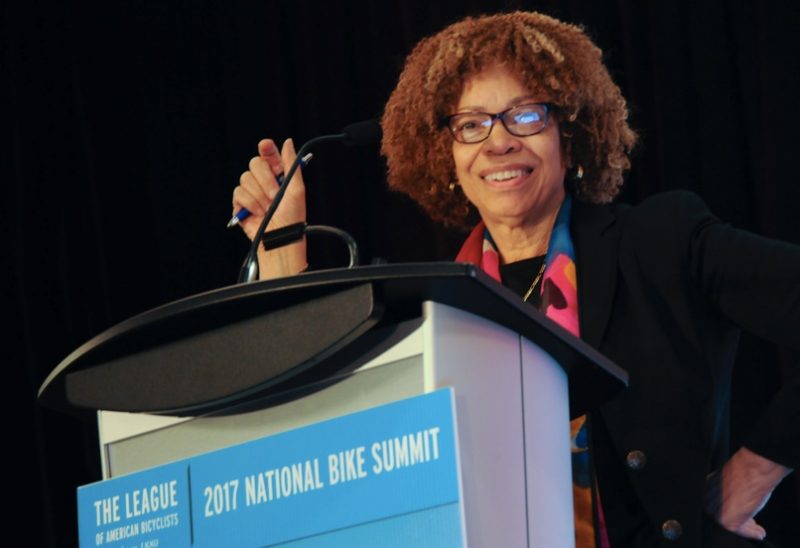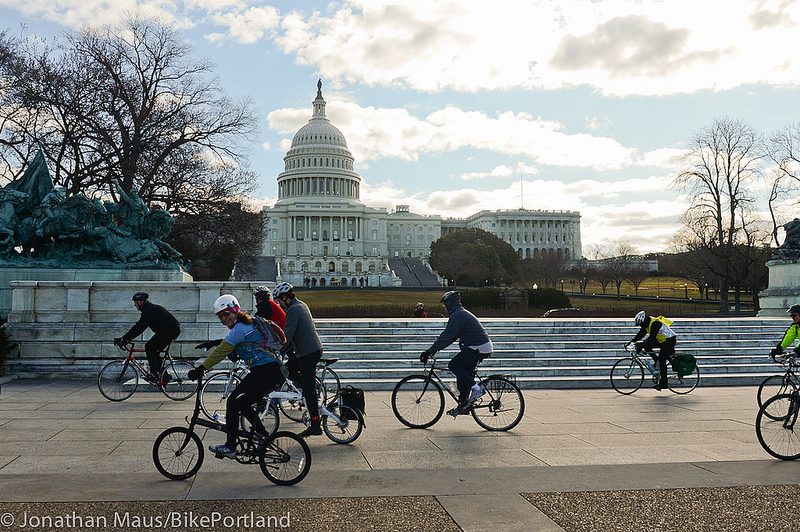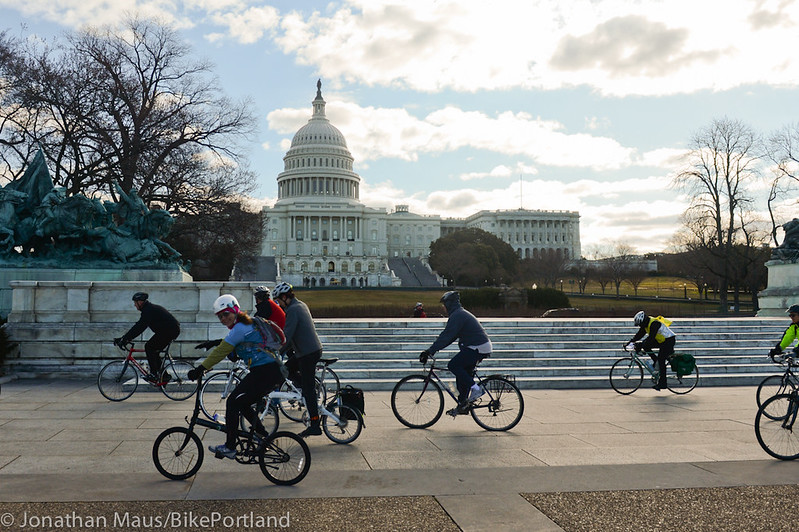Day one of the 2017 National Bike Summit is in the books. After a two-year hiatus, we decided to head back to D.C.
I was motivated to make the journey for several reasons. With the Trump era in full-swing, it seems like showing up for bikes in the nation’s capitol is more important than ever. Relatedly, I wanted to check the pulse of the national movement: If we do receive a major attack, will we be healthy enough to fend it off? Is it even possible to have a “we” anymore?
The first thing I noticed when I swung open the doors didn’t give me much confidence: The crowd assembled in the main ballroom at the Renaissance Hotel for the opening plenary looked small. Last time I attended (in 2014) there were over 700 advocates in the room. Today it looked like there was about half that.
And the Oregon delegation has dwindled at a similar rate. We used to have 20-25 Oregonians. This time there are just eight (including me).
Three members of the Oregon delegation are in this Instagram post below: The Street Trust Interim Executive Director Stephanie Noll (L), Sugar Wheel Works Owner Jude Geraci, and The Street Trust Communications Director Kate Walker.
While the Summit itself chugs along with friendly smiles, excellent networking opportunities, inspiring stories from laudable bike heroes and breakout sessions chock-full of wonky details — it feels like there’s something missing.
Maybe attendance is down due to the lack of major opportunities for biking at the federal level. A woefully dysfunctional Congress also probably tamps down enthusiasm. One of the main draws of the Summit is Wednesday’s “Lobby Day” on Capitol Hill. Perhaps many people think if there’s nothing to lobby for, there’s no reason to show up.
Advertisement

And the League itself is going through a bit of a rough patch. They just named a new interim executive director (veteran staffer Bill Nesper) after their latest leader (Alex Doty) stepped down unexpectedly after just 16 months on the job. Another troubling sign at the League is the shrinking size of their team. In 2014 they had 18 staffers. Today they have eight.
“The sad news is that we move from opportunity and being proactive, to defense. And that’s really hard.”
— Randy Neufeld, SRAM Cycling Fund Director
Then there’s the inter-movement split that appears to be happening between the League and what used to be one of their biggest partners, People for Bikes. For many years People for Bikes was a fixture at the summit. Their president, the charismatic insider Tim Blumenthal, has been a regular keynote speaker. In 2016 People for Bikes was the sole “Platinum” level sponsor of the summit.
But this year People for Bikes is nowhere to be seen. Nowhere in the agenda and nowhere on the list of sponsors.
It’s worth noting that People for Bikes recently launched a bicycle-friendly city ranking program — which puts them somewhat awkwardly into territory long-occupied by the League and their well-known Bicycle Friendly America program. A major funder of the League’s BFA program was Trek Bicycle Corporation. We can now confirm that Trek pulled its funding from the League and is now funding the People for Bikes program.
And what is People for Bikes doing for the first time this year — the first year they’re not at the League’s summit for over a decade? — they’re hosting a conference of their own: the Places for Bikes Conference this June in Wisconsin (which happens to be just 25 miles west of Trek’s headquarters in Waterloo).
Instead of growing together collaboratively like they had done for over a decade, it appears America’s two largest bike advocacy groups are going in separate directions — with one growing weaker, while the other grows stronger.
Is this good or bad for the national bike movement? Do we need just one strong and unified “voice for cycling in America”? Maybe not. I don’t know the answers to those questions. That’s one reason I’m here.
Speaking of growth, the League’s Board Chair Karen Jenkins announced tonight that she’s launched an effort to get “100,000 members in a decade”. That would be a 500 percent jump up from their current membership level of 20,000.
And in today’s political climate that type of growth could be very challenging.
One of the big questions I’m working on this week is: How will bicycling and bike advocacy change in the age of Trump?
I asked experienced policy strategist and Director of the SRAM Cycling Fund Randy Neufeld that question. You might not like his answer.
“The sad news is that we move from opportunity and being proactive, to defense,” he said. “And that’s really hard.”
Here’s more from Neufeld:
“There’s a lot of discussion about, do we spend a lot of energy defending the federal piece of active transportation funding when the state and local contribution is much bigger and much more significant? And I think — like transit — as much as we’d like to wean ourselves from the federal share [of funding], it’s still pretty damn important… I think we’re going to have to do defense. It’s also a fundraising opportunity for the movement. It’s an opportunity to reach out to new partners and create coalitions. But it does mean going into protection mode — as opposed to growing opportunites.”
We’ll very likely hear more about how cycling will fare in the Trump adminstration when Portland Congressman Earl Blumenauer takes the stage for the big Summit keynote in the morning. Speaking of which, I need to get some sleep.
Stay tuned for more coverage from D.C.
— Jonathan Maus: (503) 706-8804, @jonathan_maus on Twitter and jonathan@bikeportland.org
BikePortland is supported by the community (that means you!). Please become a subscriber or make a donation today.



